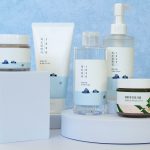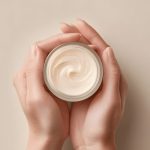“Fatty Alcohols vs. Simple Alcohols in Skincare: What New Moms Should Know” is a collaborative post.
If you’ve ever looked at the ingredient list on your moisturizer and noticed words ending in “-yl”—like cetyl alcohol, stearyl alcohol, or cetearyl alcohol—you may have felt a moment of panic. After all, many moms are taught to avoid “alcohol” in skincare, especially during pregnancy or when choosing products for baby’s skin.
So, is “alcohol” always bad in skincare?
Not at all.
In fact, there’s a huge difference between simple alcohols (often drying) and fatty alcohols (usually nourishing). Understanding this difference can help new moms make safer, more informed skincare choices—for themselves and for their babies.
Let’s break it down in a simple, mom-friendly way.
1. What Are Simple Alcohols?
Simple alcohols (also called drying alcohols) are lightweight, evaporating liquids used to help products feel weightless or penetrate faster.
Common simple alcohols:
- Alcohol Denat
- Ethanol
- Isopropyl Alcohol
- SD Alcohol
- Methanol
These alcohols can:
- dry out the skin
- disrupt the skin’s moisture barrier
- cause irritation in sensitive or compromised skin
Because postpartum and pregnancy skin tends to be extra sensitive, these forms of alcohol are often best avoided.
Sources:
- Byrdie, “Alcohol in Skincare”
- Healthline, “Alcohol in Skin Care: What to Use and What to Avoid”
2. What Are Fatty Alcohols?
Here’s the part most moms don’t know: fatty alcohols are not drying at all.
They act more like moisturizers than “alcohol” in the traditional sense.
These ingredients are derived from natural fats (like coconut or palm oil) and help give creams their creamy, buttery texture.
Common fatty alcohols:
- Cetyl Alcohol
- Stearyl Alcohol
- Cetearyl Alcohol (a mix of cetyl + stearyl)
- Behenyl Alcohol
Fatty alcohols are:
✔ Emollient (soften and smooth the skin)
✔ Moisture-locking
✔ Barrier-strengthening
✔ Safe for pregnancy
✔ Safe for breastfeeding
✔ Safe for baby skin (generally non-sensitizing)
Fatty alcohols help maintain skin hydration and improve product stability—making them essential in moisturizers and baby products.
3. Why Do Moms Confuse the Two?
Because both types share the word “alcohol”, many consumers assume they behave the same way.
But chemically, they’re completely different:
| Type | Function | Effect on Skin |
| Simple Alcohol | Fast evaporation, penetration | Can dry, irritate |
| Fatty Alcohol | Moisturizing, thickening | Nourishing, hydrating |
So if your moisturizer contains “cetearyl alcohol,” don’t worry—it’s skin-friendly.
4. Are Fatty Alcohols Safe During Pregnancy?
Yes—fatty alcohols are considered safe during pregnancy and breastfeeding.
They do not behave like oral alcohol (ethanol).
They do not penetrate the bloodstream.
They do not pose risks to fetal development.
Dermatologists consistently recommend fatty alcohol-based moisturizers because pregnancy hormones often cause:
- dryness
- sensitivity
- itchy skin
- eczema flare-ups
- compromised skin barrier
Fatty alcohols help support and protect the skin barrier when it’s at its most vulnerable.
Dermatologists on Tabeebo often recommend barrier-supporting moisturizers containing cetearyl alcohol and stearyl alcohol for pregnant women dealing with dryness or sensitivity.
5. Are Fatty Alcohols Safe for Baby Skin?
In most cases—yes.
This is why many baby creams, diaper-rash creams, and gentle cleansers include fatty alcohols.
Benefits for baby’s skin:
- extra hydration
- barrier repair
- minimal irritation
- soft, creamy textures (easy to apply)
However, any ingredient can rarely trigger sensitivity, so parents should still patch-test products on newborns.
6. Fatty Alcohols in “Clean Beauty” and Natural Products
People care deeply about clean, toxin-free products, so here’s the good news:
Fatty alcohols are widely accepted in:
- clean beauty
- organic skincare
- plant-based products
- dermatologist-approved formulas
They’re often derived from coconut oil or palm oil, and are considered low-risk, gentle cosmetic ingredients.
Cetearyl alcohol is even approved for use in cosmetics certified by ECOCERT and COSMOS.
7. Fatty Alcohols and Acne—Should You Worry?
Good news: fatty alcohols are not considered inherently comedogenic.
According to dermatology research:
- They are not pore-clogging when used in typical cosmetic percentages
- they can actually help regulate moisture, preventing the dehydration-oil cycle that triggers breakouts
However, acne-prone skin is highly individual.
If a product causes breakouts, it is usually due to the entire formula, not the fatty alcohol alone.
8. How to Identify Fatty Alcohols on Ingredient Lists
Look for ingredients ending in:
- -yl alcohol
- -yl (e.g., cetyl, stearyl)
- alkyl alcohols
Examples:
- cetearyl alcohol
- behenyl alcohol
- myristyl alcohol
Avoid simple alcohols, such as:
- Alcohol Denat
- SD Alcohol
- Ethanol
This helps moms choose gentle, safe formulas during pregnancy and beyond.
9. When Should You Avoid Fatty Alcohols?
Fatty alcohols are well-tolerated, but caution is recommended if:
- You have a history of coconut or palm oil allergies
- You’ve reacted to emulsifiers or thickening agents
- You’re experiencing active dermatitis and want to test one product at a time
Even with their excellent safety profile, listening to your skin always matters.
10. Final Thoughts: Fatty Alcohols Are a Friend, Not a Foe
For many moms, skincare becomes more important—and more confusing—during pregnancy and postpartum. The good news? Fatty alcohols are not drying or harmful. They’re actually skin-nourishing ingredients found in many safe, gentle, hydrating products for both mothers and babies.
So next time you see “cetearyl alcohol” on a label, take a deep breath.
It’s there to protect and moisturize, not irritate.






Comments are closed.